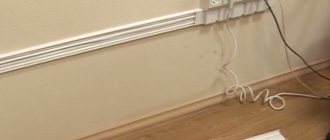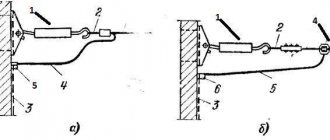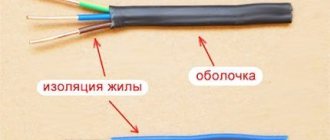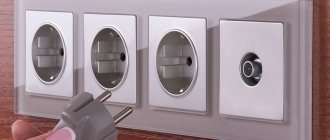The concept of external trays
Boxes made of plastic or metal, most often U-shaped, designed to accommodate electrical wires are called cable channels. They are used outdoors or indoors.
The components of the channel are a box and a cover. The vast majority of these products are square or rectangular, but there are also other shapes for special tasks. The body is mostly monolithic, less often with perforations intended for ventilation inside the box. The connection between the lid and the body occurs through a lock that snaps into place when pressed. You need to pay attention to high-quality closure when purchasing, since you will have to use it quite often when adding a new cable or making repairs. A channel with a double lock would be optimal.
Some trays can be divided internally into sections. Such a device will help separate power lines from low-current ones, such as television antennas, network cables, alarms and control wires. Partitions can be stationary or removable. For the latter there are special mounting connectors. It is important that the plastic channels are non-flammable or non-flammable. This characteristic is indicated in the product description.
Selecting an electrical box
Plastic trays with a lid are ideal for installing power supply networks indoors. The sale is dominated by various shades of white, which look harmonious against the background of the many colors in which the walls and ceilings of houses are decorated. The main selection criterion will be the width of the box, which should accommodate all the cables being mounted. It is calculated with a reserve for future needs.
Reserves are also required for the length of the route. Usually it is ten to fifteen percent of the total length of the line. The width of the main line box is, as a rule, larger than the branches to other consumers.
When purchasing the main wiring part, you must not forget about the fittings: transitions, plugs, joints. These elements will simplify the installation process and make the appearance of the route much more aesthetically pleasing.
And, of course, all parts of the structure should not have cracks, chips, or other defects. This is especially true for the ends, which are difficult to fit perfectly if cut unevenly. Some buying tips:
- Cable ducts in the form of corrugated pipes are intended exclusively for flexible wire.
- Small profile boxes are cut with a sharp knife, wide ones - with a saw with a fine tooth. When using an angle grinder, the profile may melt.
- Installation of cable channels begins with electrical fittings (lights, sockets, switches, junction boxes).
- The quantity of fasteners is purchased at the rate of one piece for every half meter of tray.
- Rigid profile boxes are installed on flat surfaces.
Requirements
Plastic insulators in the form of long boxes can be used for open wiring. Properly installed boxes will look good in any interior. When installed in residential and office premises, it meets several basic requirements:
- The box should be beautiful to look at.
- Provide easy access to cables and wires.
- Not flammable.
Types and sizes
There are several types of cable channels . They do not shine with a wide variety of forms ; only the trays for special conditions of use, the standard size and the material for their manufacture differ.
Cable trays in baseboards
For the production of cable systems at home, this is the best option. The wires are placed in the body of the baseboard. In this case, you can avoid labor-intensive and dusty work on cutting hidden wiring and get a beautiful and reliable power supply circuit at the output. Aesthetics are achieved through an expanded color range of finished products and imply a creative approach to the process.
A wide range of additional components are available for such products, which will help make transitions, turns and route endings unnoticeable. There are plinth fittings for various cable outlets, which allows you to mount sockets, connectors and adapters at floor level.
Sizes vary slightly among different manufacturers:
- The Legrand company produces two series of decorative cable ducts for external wiring. This is a Mini collection with dimensions 20 by 12.5 mm, 32 by 12.5 mm, 40 by 12.5 mm, 32 by 16 mm, 40 by 16 mm, 60 by 60 mm, 60 by 20 mm, 75 by 20 mm and DPL with dimensions 35 by 80 mm; 35 by 105 mm, 50 by 80 mm, 50 by 105 mm, 50 by 150 mm, 65 by 150 mm.
- SL Hager offers a choice of the following dimensions: 20 by 50 mm, 20 by 70 mm, 15 by 100 mm, 25 by 100 mm.
Floor boxes
Such installation products have a semicircular cross-section. This was done to ensure human safety when moving, since the name suggests that such channels are attached to the floor surface. Such systems are used mainly to replace carriers and extension cords. It turns out beautifully and is not dangerous: it is not difficult to trip over a dangling wire.
Trade enterprises offer a choice of products with dimensions: 50 by 12 mm, 75 by 17 mm, 92 by 20 mm, 160 by 65 mm. Standard colors include white, gray and black channels. You can choose turns, bends and transitions for them. The lid snaps into place. Cable channels for the floor have a degree of protection IP40.
Parapet profile
Such cable trays are called trunk cable trays. They differ from baseboard ones in shape and installation location. They do not have a variety of colors and are available in white or milky color. All kinds of fittings are available to facilitate installation. Most often they are used for laying cables in the office or in production. Often such products are used when installing air conditioners.
The standard width of parapet boxes is 80, 100, 120, 150 millimeters, wall height is 40, 55 or 60 millimeters.
There is a version of these trays with smaller sizes. There are no additional accessories available for them, and during installation the box is cut out at the desired angle. A wide variety of sizes allows you to mount the combination for any type of cable:
- Width from ten to one hundred millimeters.
- Height - from ten to sixty millimeters.
Angled cable management systems
For installation work at the joints of walls or ceilings, there is an angular cable channel. They are made in the likeness of a ceiling plinth and at a quick glance they resemble part of the decor. Their dimensions are limited and are not suitable for laying a large bundle of cables. There are no docking points for them. The most common channels are forty by forty millimeters in size.
Corner trays with a transparent lid are suitable for laying lighting lines from LED strips. Suitable for illuminating furniture.
Metal cable ducts
Such boxes are used for installing wiring in wall cavities - frame or panel houses. They are used in production to connect various equipment. The material is usually galvanized metal. For connections or bends, special products with screw fasteners are used.
Such structures are widely used for laying wires for various purposes inside suspended ceilings. With the help of such trays, the process of installing power supply circuits is accelerated and simplified, since the standard length (three meters) allows you to assemble long sections of the main line at once, without resorting to various fasteners. The width of the tray is from fifty to six hundred millimeters or more, the height of up to one hundred millimeters allows you to lay any number of wires.
Flexible channels
Such channels are also called track channels because of their appearance, reminiscent of a tank caterpillar. The main purpose of such products is to provide power to the moving elements of the electrical circuit. There are also flexible channels in the form of a corrugated PVC tube. It is used mainly in industrial facilities. The varied diameters of the products allow for laying cables of several sections. The production material for flexible trays is non-flammable plastic.
Installation of different types of channels
Conventionally, the channels can be divided into several groups according to the installation site. They will have their own characteristics.
Floor-standing
These structures are used to protect information wiring and fiber optic cables. Provide a high level of electrical safety during redevelopment.
The design allows easy access to damaged parts in case of an emergency. In addition, such cable channels are used to supply conductors to service racks.
The base is steel or aluminum. Provides high strength and operation at temperatures from -15°C to +60°C.
Skirting
Such floor cable ducts include several chambers into which power and information lines can be laid separately from each other. As the name implies, it is recommended to install such devices under the baseboard and not along the walls.
The electrical wiring laid under the baseboard can be removed at any point convenient for the user. An important visual advantage is the coloring of such boxes. They are usually made to resemble wood, making them difficult to distinguish from ordinary wooden baseboards.
Corner
Such products are additional to ceiling and plinth boxes. They have section sizes from 10 mm to 300 mm and above. Allows you to run multiple cables at the same time. The shapes are straight and round.
Wall mounted
To lay conductors along the walls, boxes made of PVC material are used. Their installation does not require special knowledge and skills, and they are also lightweight. They can be attached either to special clamps or to an adhesive base.
Parapet
Plastic wiring boxes have external, flat and internal corners, allowing installation to be carried out as quickly and accurately as possible. Sold in lengths of about 2 meters. The operating temperature range is from -32°C to +90°C. It is recommended to install at temperatures from -15°C to +60°C.
Flexible
Rolled or flexible junction boxes are rectangular in shape. Double-sided tape is attached to the side walls for quick and quality installation. There are also holes that allow fastening with self-tapping screws to the surface. The material used for the box is an instantly attenuated PVZ with increased strength.
Has a wide color variety. The minimum size is 7x12 mm, the maximum is 18x33.
Installation of electrical wiring from cable ducts
The process and features of arranging power supply are interconnected with the type of cable trays that will be used in the work. You need to decide on the number of auxiliary components and cable channels, the sizes that are available for sale. If there are special manufacturer requirements, they must be studied and followed.
Selection of dimensions
Before starting work, you need to familiarize yourself in detail with the future wiring diagram. Determine the number of wires and the cross-section of their cores in order to measure the thickness of the conductor bundle in each individual section. By adding the necessary margin for laying possible cables in the future, the size of the cable channel for each thread of wiring is determined.
If power and low-current wires are to be placed in a common tray, it is recommended to purchase a channel with a dividing wall. If this is not available, you can leave a distance between the conductors and tighten them with flexible clamps according to the voltage class.
The number of wires laid in one cable channel is limited only by its dimensions. As long as the lid does not squeeze out and if necessary, you can get free access to any wire.
Features of laying cables in trays
The basic rule of any wiring is that the installation is carried out strictly horizontally and vertically. Corner areas are not permitted, with the exception of staircases. The edges of the cut boxes must be smooth, which is achieved by using rulers, measuring squares and sharpened tools. For metal trays, you can use an angle grinder.
The rule is measure seven times, cut once , in this case it is used for any marking of profiles of the required length. Marking is done on the assembled cable channel, and only before cutting is the cover removed.
When forming angular internal bypasses, the cover is cut on the walls for bending, and on the outer ones it is cut slightly longer than the channel itself.
Products for fastening are selected depending on the coating material with which to work. The trays are nailed to the wooden base with wide-headed nails, to the brick using dowels and nails, and to the drywall with self-tapping screws. In places where boxes are joined, the distance between the fastening elements should be within four to six centimeters, in other cases - fifty to sixty centimeters.
To make the joints less noticeable visually, the boxes and lids themselves need to be connected in different places. Wires can be laid in the prepared route. On long sections, the harnesses can be tied with clamps and secured with jumpers. And don't forget to latch the lids.
Installation methods
Plastic cable channels are easy to install with your own hands and can be done in three ways:
- Glue. The option that is called “forever” is worth gluing once and then you have to peel it off along with the coating. But in some situations, a completely acceptable installation method. Before applying the glue, it is advisable to sand the back of the channel.
- Double-sided tape. It is much more pleasant to work with than glue, but the reliability of this method is not very high. Therefore, it is suitable only for small sections of channels with low load. In addition, if you have to remove the products in the future, the double-sided tape will leave marks on the surfaces that are difficult to remove.
- Self-tapping screws. This method is most preferable due to its high reliability and the possibility of repeated installation/dismantling of the structure. Especially if the installation is carried out on a wooden floor.
For metal cable channels, self-tapping screws are perhaps the only installation option. To properly distribute the load, it is recommended to fix the screws in a zigzag pattern.
Before starting work on installing channels, it is advisable to draw up a layout diagram for the wiring cables. This will make it more convenient to calculate the required number of products and accessories for them. If you are going to do the work yourself, then it is recommended to use a hacksaw to cut the channels. You can, of course, try a stationery knife, but then you will have to work hard. For metal, a hacksaw or grinder is definitely used.
Advantages and disadvantages of electrical channels
Having settled on the option of open installation of cable routing, it is necessary to analyze the pros and cons of this method and try to maintain the advantages during the work, and reduce the negative phenomena or avoid them altogether.
Pros of using trays:
- Low labor intensity compared to wall gating.
- They can be installed anywhere.
- Constant free access in case of a malfunction or the need to lay an additional power line.
- Quite a high degree of protection of wires from mechanical damage.
- High speed of route installation.
- A large number of cable channel options allows you to combine the power supply line with the interior of the premises.
Minuses:
- The need for additional space, albeit minor.
- Need for additional fittings.
- Possibility of accidental damage (especially in the floor version).
- Sometimes it is not possible to choose a tray exactly to match the main interior background.
Having dealt with all the subtleties in installing cable channels when installing electrical wiring, you can always find a suitable solution that suits you in terms of reliability, ease of use, and design. Moreover, new engineering solutions for laying wires without major interventions in the design of buildings and structures are appearing on the market.
No. 8. Manufacturers of cable channels
As you know, the name of the manufacturer is a kind of guarantee of quality. If substantial funds have been invested in advertising and promotion, then who would want to spoil it all with dubious products. Among the leaders in terms of cable channel production it is worth noting:
- Hager is a German company that mainly produces channels for office spaces, but their attractive appearance allows the products to be used in residential areas;
- Schneider Electric is a large European corporation with factories around the world, incl. and in Russia. The range of cable channels is one of the widest among all competitors. There are plastic and metal products, models for installation on the floor and walls, boxes of different sizes are available, incl. and mini versions;
- DKS are domestically produced channels, there are wall and floor options, as well as mini cable channels. The range of colors is not very large, but in most cases it is quite possible to find a suitable product;
- Legrand is a group of companies with offices around the world that produces a wide range of products under different brands. Cable channels are presented in plastic and aluminum versions, floor and wall models, sizes vary widely;
- IEK - a domestic manufacturer, offers parapet and wall cable channels of different sizes, color - white and imitation wood.











